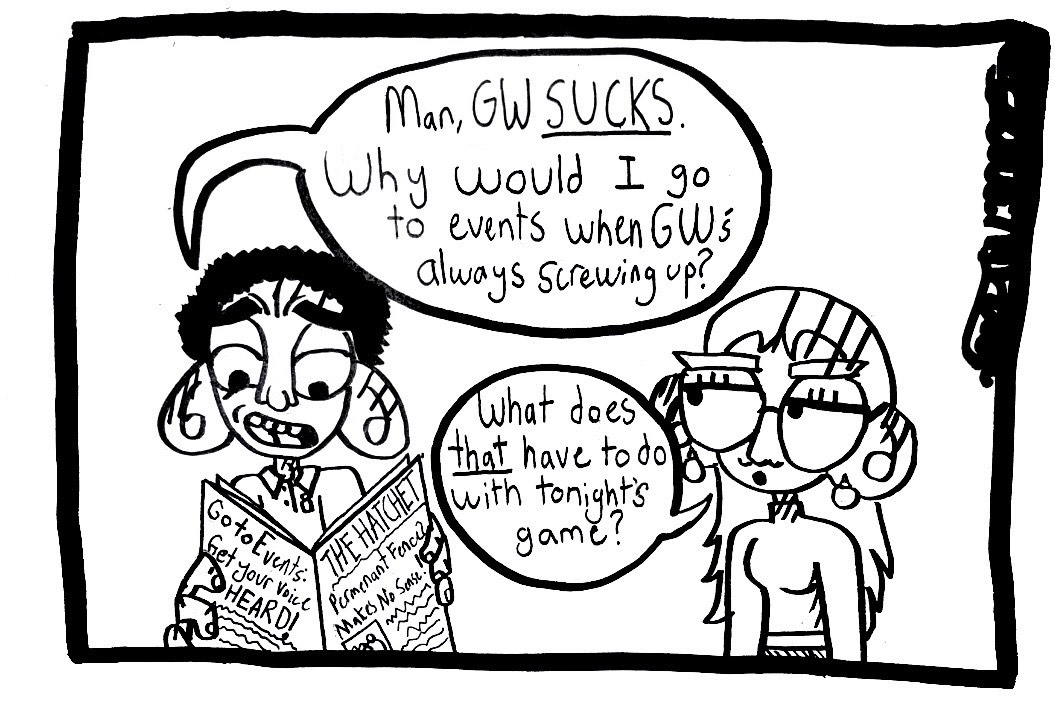
We always hear the same advice about staying safe on our urban campus: Be aware of your surroundings, walk with friends and stay in well-lit areas. But there are some things we can’t control, including how “well-lit” our campus is.
Campus lighting is something the University can change. And given the volume of crime happening in certain areas on campus, like the walkway next to the Metro, it’s time for GW and the University Police Department to get creative. I’ve only been at GW for two months and I’ve already noticed how poorly lit parts of campus and their surrounding areas are. Our best-lit spot seems to be outside The Avenue apartments, an area on the edge of campus.
There are many places on campus that could use some more light, like in front of the townhouses on F Street, the walkway between Phillips and Smith Halls, University Yard and I Street, where the construction of District House is taking place. GW needs to conduct a study that investigates whether campus lighting is sufficient and look for improvements to make over the next few years.
I tend to feel pretty safe on campus. But last year’s campus climate survey about sexual violence found that about 21 percent of female freshman felt unsafe on campus at night. And even I still occasionally feel uneasy and try to be attentive to anything suspicious around me. Getting alerts from the University about sexual assaults, robberies and attacks is helpful, but can also heighten students’ fears about going outside at night, especially in areas of low light.
At Colby College, students had the same fears about lighting on campus and how it affected their safety. So in 2009, two students conducted a study that analyzed the outdoor lighting on their campus. They concluded that their school’s lighting was not uniform and left many areas in darkness.
Since that study and following students’ complaints, Colby College has continued to analyze light conditions on campus and make changes. The school has targeted certain areas and prioritized improvement to lighting in those spots, taking student input into account. They’ve also started updating old light fixtures, in addition to adding new ones around campus.
Rather than waiting for students to conduct a study like the one at Colby College, the University should do its own. It would allow GW to pinpoint certain areas of darkness and work to improve the lighting in those spots. Places that are completely dark should be prioritized and made safer as soon as possible.
“As an urban campus, much of the lighting on GW’s campuses is on public space and therefore under the purview of the D.C. government,” University spokesman Kurtis Hiatt said in an email. “When renovating or completing a new building, we work with the D.C. government to ensure our lighting plan fulfills D.C.’s requirements.”
Hiatt also noted that GW can work with the city to make additional lighting requests if necessary. If the University conducted this study and found that it needs help from D.C. to make changes, it’s likely they could get it done.
The study would also allow GW to analyze the correlation between dark areas and the location of crimes. Although correlation does not equal causation, it wouldn’t hurt to have more information about the conditions in areas where crime occurs.
GW has a history of supporting student safety. Last year, the University released the PAL app, which allows students to alert UPD to their exact location on campus. GW has also improved its 4-RIDE service and UPD Chief RaShall Brackney is focusing on improving officers’ relationships with the student body. But there’s always room for improvement.
At night, perpetrators feel detached from the crimes they’re committing. Studies have shown that it’s not just about the reduced threat of being caught, but committing crimes at night is also human instinct. In the dark, people feel anonymous and the only way to curb that feeling of anonymity is by adding more light.
Of course, like anything else, it will cost money for GW to study the correlation between low lighting and crime on our own campus. But safety is a major selling point for prospective students and their parents, and it’s the University’s job to protect us during our time here. The investment would be worth it.
Keeping our campus well-lit will help us pinpoint problem areas and keep our urban campus a little bit safer.
Elias Economou, a junior majoring in finance, is a Hatchet opinions writer. Want to respond to this piece? Submit a letter to the editor.




